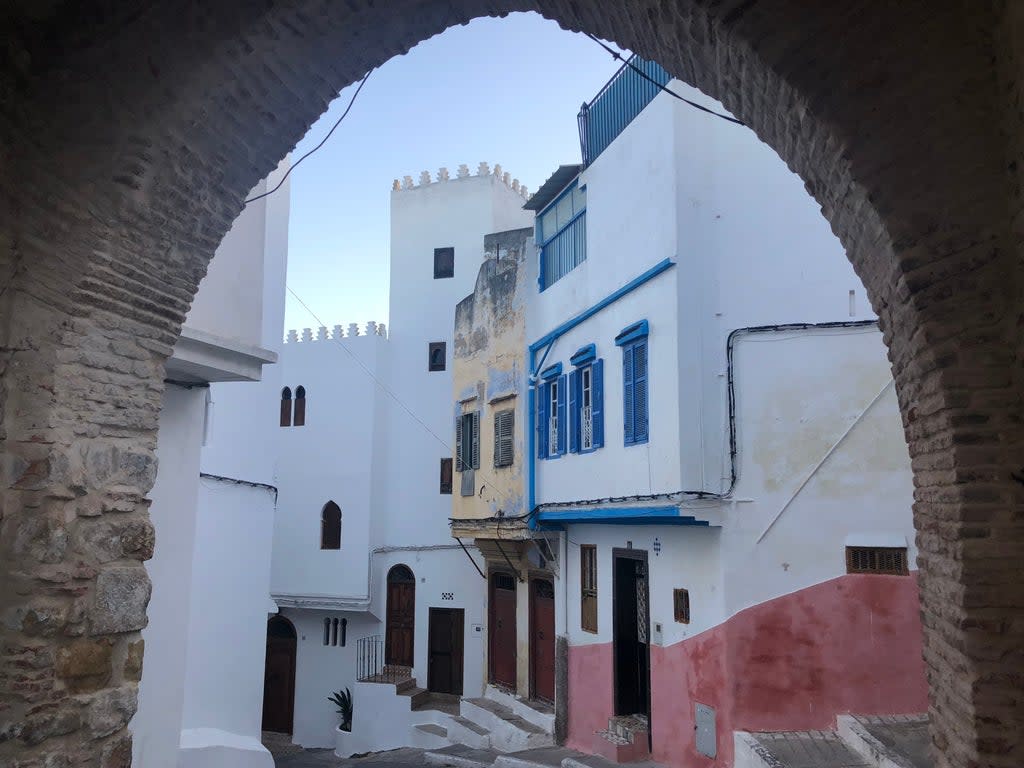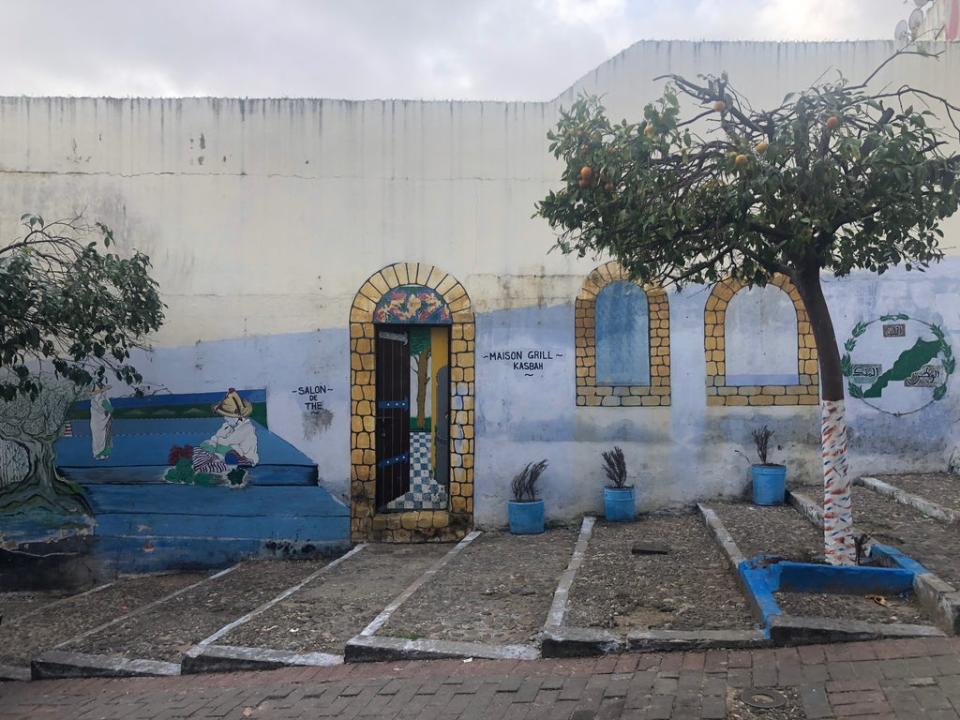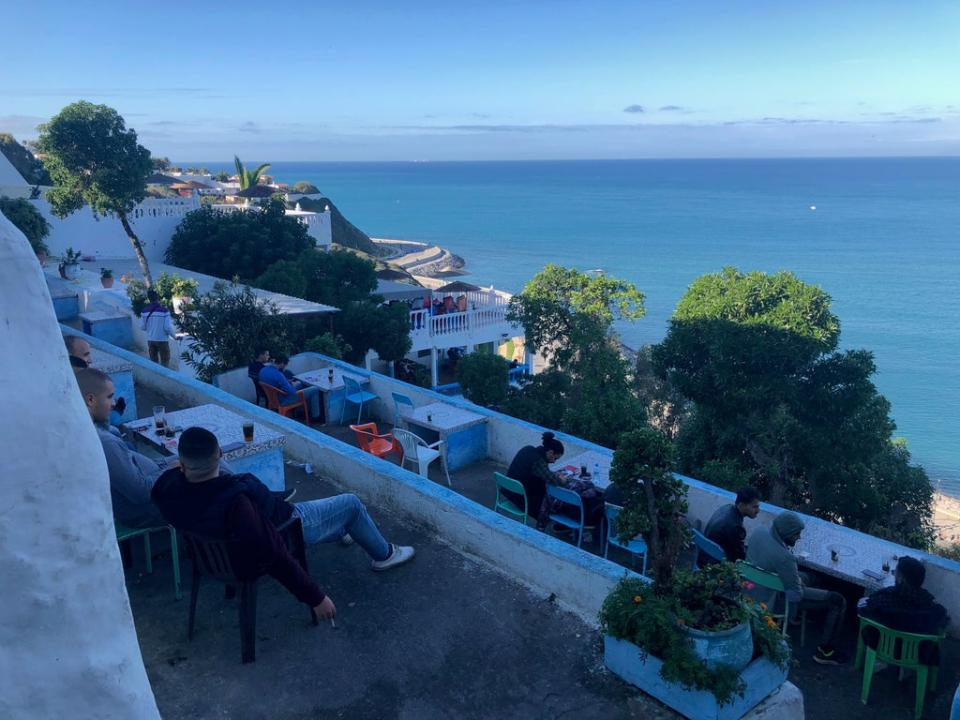Tangier’s new dawn – how Morocco’s dissident dive got its mojo back

It’s a crisp winter’s day with wood smoke clinging to the air, and high in the Kasbah of Tangier, Cafe Baba is busy. A knot of teenagers has blocked off a corner of the balcony in pursuit of a board game. A lone smoker stares out to sea through tall horseshoe windows that skim white rooftops. If it weren’t for the flatscreen TV pumping out hip-hop you could say this Tangier coffeeshop, with its ripped seats and chipped Arabesque tiles, has changed little since the 1950s, when it served marijuana to writers like Jack Kerouac, Allen Ginsberg and William Burroughs.
Like so many establishments in Tangier, Cafe Baba is legendary for its back catalogue of visitors. First came the Beat writers, then the hippie generation and musicians such as Jimi Hendrix, Mick Jagger, Santana and Sting. A black-and-white photo on the wall shows the bleary-eyed Rolling Stones lounging here in 1967 with cafe owner Hnifza. Hnifza is still around, but these days it’s his grandson Mohamed who manages the flow of mint tea at Cafe Baba.
Dissolute past
Crowing over the tip of Africa just 35 miles from Spain, Tangier has always had a reputation for being different. Between 1912 and 1956, the city was an international zone that belonged collectively to Morocco, France, Belgium, Holland, Portugal, England, Italy and Spain. It became a place where artists, misfits, libertarians and dissidents came to lead freewheeling lives, in a stop-gap between the Moroccan French protectorate and the corseted powers of Europe across the Strait of Gibraltar. Even today, the population of Tangier is more diverse than anywhere else in Morocco, with 40 per cent being non-Muslim.

After Moroccan independence, King Hassan II effectively locked the doors on Tangier and threw away the key. Rot took hold, wafting through the streets of the medina like a sour sea breeze. In the 1980s and 1990s, the city became known as a dodgy destination for tourists, with a down-at-heel medina full of hustle. It wasn’t until King Hassan II’s progressive son, Mohammed VI, took over, that Tangier was slowly brought back into the fold. Today investment is pouring in, and the city is changing as a result.
City on the brink of change
“Tangier is the gateway to Africa and the gateway to Europe,” said my guide Ali as he led me around the medina, his djellaba billowing as we encountered coastal breezes high in the Kasbah lanes. The city’s geographical position, which once helped forge Tangier’s unique relationship with Europe, is now being used to turn Tangier into a key industrial zone for the Moroccan government and a commercial gateway to Africa.
The pre-pandemic completion of the Tanger Med 2 port expansion, 50km east of the city, is set to make Tangier the largest commercial port in the Mediterranean by container capacity. Meanwhile, a recent high-speed TGV train link to Casablanca and the capital Rabat is bringing in wealthy Moroccan weekenders, and redevelopment of the city-centre ferry port - to include a lifestyle marina - is expected to entice the luxury yachting set.
There was unmistakably something in the air – besides the perfume of rose water and grilling sardines – that lent a little bit of magic to Tangier
After showing me the city’s Roman cemetery, seated so precariously on a cliff edge it looks ready to topple into the Mediterranean, Ali and I skirted the dramatic fortified Kasbah walls built by the Portuguese in the 15th century to keep out invading Brits (Tangier was later given as a dowry pledge to King Charles II when he married Portugal’s Catarina de Braganza in 1662).
At Bab Al Bahr, a clifftop gate that frames Tarifa in Spain like a postcard across the Strait of Gibraltar, Ali pointed to the marina below. “We say you can see Tangier in the future down there,” he said. “Forty years ago there was nothing. Now look at all the buildings.”
When I visited in 2019, Tangier’s construction boom was in full swing. On my way into town from the airport, I passed empty parcels of land, hoardings advertising soon-to-be golf resorts and a new giant mall. Down at the waterfront, 8ft boards promised a W hotel conference centre and showed a slick, landscaped vision of the Tanger Ville port and marina redevelopment, temporarily obscuring the sea view from a row of Italianate period buildings along the promenade.

Tangier’s soul
Yet Tangier’s old core was still disarmingly lovely. Buildings that date from the 14th century were being repainted brilliant white, green spaces were being landscaped, and investment had inspired a legion of entrepreneurs who embraced the city’s bohemian spirit. One of them was Saba’s House, the first five-star riad where I stayed, around the corner from Cafe Baba. It opened in February 2019 and had already hosted the Prince of Chad by the time I visited.
Owner Roya is a Tunisian businesswoman whose husband was born in this house. It took her two years to convert it into a stylish art-deco retreat with six rooms named after luminaries with links to Tangier. I was in the Mick Jagger room; the others are Antoni Gaudi, Elizabeth Taylor, Ibn Battouta (a 14th-century Tangiers-born explorer), Malcolm Forbes and Barbara Hutton. Hutton, a troubled New York socialite who decamped to Tangier after a brief marriage to Cary Grant in the 1940s, lived in the riad that adjoins Saba’s House.
Outside the door of the hotel, the Kasbah streets are a warren of small boutiques. A sparkly tarbouche here, some 1960s-style harem pants there. Posters in shop windows advertised book readings, gallery exhibitions and jazz nights. There was unmistakably something in the air – besides the perfume of rose water and grilling sardines – that lent a bit of magic to Tangier. Shop owners talked about the city’s soul.
At concept store Las Chicas, I met Yasmine and Ayda, who sell high-end Moroccan-made homeware and fashions, while running an in-shop tea room with gilded rococo chairs and a menu of tarte tatin and Buddha bowls. “It’s true there’s a lot of change,” said Yasmine, “but Tangier is always Tangier and I have this feeling like time has stopped here.”
Cafe culture
My tour of the medina also took in the renovated Kasbah Museum and the American Legation Museum, with its wing dedicated to American composer Paul Bowles, who settled in Tangier in 1947. Tourist attractions are few and far between though, so I returned to Tangier’s storied coffeehouses. Perhaps the most unique is the period cafe inside art-deco Cinema Rif, where I found Tangier’s creative types in skinny jeans and lumberjack shirts communing over espresso amid vintage posters advertising Joan Fontaine flicks.

I followed the trail of the Beat writers to Gran Cafe de Paris, an old-fashioned people-watching spot. And Cafe Hafa, founded in 1921, where the magnanimous sea views from bare terraces inspired visions of Burroughs bent over his manuscript of Naked Lunch here in the early 1950s, his prose no doubt fuelled by a never-ending stream of mint tea.
High on caffeine, I made my last stop at the Morocco Club, a busy bar and restaurant inspired by the 1930s Manhattan club of the same name. I was shown to a zebra-print sofa in a saffron-coloured room with photos of Elizabeth Taylor and Mick Jagger on the walls. Oysters were being ordered, lavish parties discussed, and it felt like I’d entered a clubhouse for Tangier’s literati, expats and entrepreneurs. It was utterly seductive, and a perfect tribute to Tangier’s louche past. The city may be evolving, but the beat of old Tangier goes on.
Travel essentials
Where to stay
High in the Kasbah, with sea views from an elegant glass-walled roof terrace, Saba’s House is a luxurious riad with excellent service. Doubles from £233, B&B, bookable though i-escape.
For a budget option try Dar el Kasbah, set in a period building on lively Rue de la Kasbah with a reading corner, occasional art exhibitions and comfy courtyard. Doubles from £39, B&B.
Getting there
It’s usually possible to visit Tangier from Europe without taking a flight, thanks to a handful of ferries from Spain and France. The most convenient route is Tarifa-Tangier Ville with FRS, although it has been paused during the pandemic. Intershipping is operating a regular service from Sete and Marseille in France, with the journey taking around 45 hours and currently costing around £370 return.
Air Arabia flies direct to Tangier from London Gatwick.
Read More
Trail of the unexpected: West Africa
These are the African cities you need to visit
Madagascar famine becomes first in history to be caused solely by climate crisis

 Yahoo News
Yahoo News 